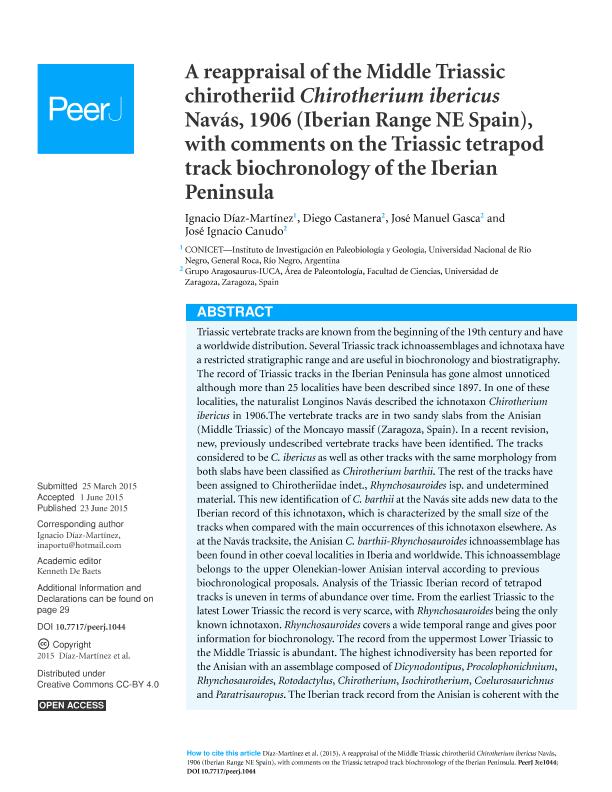Mostrar el registro sencillo del ítem
dc.contributor.author
Díaz Martínez, Ignacio

dc.contributor.author
Castanera, Diego
dc.contributor.author
Gasca, José Manuel
dc.contributor.author
Canudo, José Ignacio
dc.date.available
2018-08-02T19:31:59Z
dc.date.issued
2015-06-23
dc.identifier.citation
Díaz Martínez, Ignacio; Castanera, Diego; Gasca, José Manuel; Canudo, José Ignacio; A reappraisal of theMiddle Triassic chirotheriid Chirotherium ibericus Navás, 1906 (Iberian Range NE Spain), with comments on the Triassic tetrapod track biochronology of the Iberian Peninsula; PeerJ Inc.; PeerJ: Paleontology and Evolutionary Science; 2015; 6; 23-6-2015; 1-36
dc.identifier.issn
2167-8359
dc.identifier.uri
http://hdl.handle.net/11336/53961
dc.description.abstract
Triassic vertebrate tracks are known fromthe beginning of the 19th century and have a worldwide distribution. Several Triassic track ichnoassemblages and ichnotaxa have a restricted stratigraphic range and are useful in biochronology and biostratigraphy. The record of Triassic tracks in the Iberian Peninsula has gone almost unnoticed although more than 25 localities have been described since 1897. In one of these localities, the naturalist Longinos Navás described the ichnotaxon Chirotherium ibericus in 1906.The vertebrate tracks are in two sandy slabs from the Anisian (Middle Triassic) of the Moncayo massif (Zaragoza, Spain). In a recent revision, new, previously undescribed vertebrate tracks have been identified. The tracks considered to be C. ibericus as well as other tracks with the same morphology from both slabs have been classified as Chirotherium barthii. The rest of the tracks have been assigned to Chirotheriidae indet., Rhynchosauroides isp. and undetermined material. This new identification of C. barthii at the Navás site adds new data to the Iberian record of this ichnotaxon, which is characterized by the small size of the tracks when compared with the main occurrences of this ichnotaxon elsewhere. As at the Navás tracksite, the Anisian C. barthii-Rhynchosauroides ichnoassemblage has been found in other coeval localities in Iberia and worldwide. This ichnoassemblage belongs to the upper Olenekian-lower Anisian interval according to previous biochronological proposals. Analysis of the Triassic Iberian record of tetrapod tracks is uneven in terms of abundance over time. From the earliest Triassic to the latest Lower Triassic the record is very scarce, with Rhynchosauroides being the only known ichnotaxon. Rhynchosauroides covers a wide temporal range and gives poor information for biochronology. The record from the uppermost Lower Triassic to the Middle Triassic is abundant. The highest ichnodiversity has been reported for the Anisian with an assemblage composed of Dicynodontipus, Procolophonichnium, Rhynchosauroides, Rotodactylus, Chirotherium, Isochirotherium, Coelurosaurichnus and Paratrisauropus. The Iberian track record from the Anisian is coherent with the global biochronology proposed for Triassic tetrapod tracks. Nevertheless, the scarcity of track occurrences during the late Olenekian and Ladinian prevents analysis of the corresponding biochrons. Finally, although the Iberian record for the Upper Triassic is not abundant, the presence of Eubrontes, Anchisauripus and probably Brachychirotherium is coherent with the global track biochronology as well. Thus, the Triassic track record in the Iberian Peninsula matches the expected record for this age on the basis of a global biochronological approach, supporting the idea that vertebrate Triassic tracks are a useful tool in biochronology.
dc.format
application/pdf
dc.language.iso
eng
dc.publisher
PeerJ Inc.
dc.rights
info:eu-repo/semantics/openAccess
dc.rights.uri
https://creativecommons.org/licenses/by-nc-sa/2.5/ar/
dc.subject
Chirotherium Ibericus
dc.subject
Chirotherium Barthii
dc.subject
Middle Triassic
dc.subject
Iberian Peninsula
dc.subject
Triassic Geochronology
dc.subject
Vertebrate Tracks
dc.subject.classification
Meteorología y Ciencias Atmosféricas

dc.subject.classification
Ciencias de la Tierra y relacionadas con el Medio Ambiente

dc.subject.classification
CIENCIAS NATURALES Y EXACTAS

dc.title
A reappraisal of theMiddle Triassic chirotheriid Chirotherium ibericus Navás, 1906 (Iberian Range NE Spain), with comments on the Triassic tetrapod track biochronology of the Iberian Peninsula
dc.type
info:eu-repo/semantics/article
dc.type
info:ar-repo/semantics/artículo
dc.type
info:eu-repo/semantics/publishedVersion
dc.date.updated
2018-07-11T15:01:03Z
dc.identifier.eissn
2376-5992
dc.journal.volume
2015
dc.journal.number
6
dc.journal.pagination
1-36
dc.journal.pais
Estados Unidos

dc.journal.ciudad
Nueva York
dc.description.fil
Fil: Díaz Martínez, Ignacio. Universidad Nacional de Río Negro. Sede Alto Valle. Instituto de Investigaciones en Paleobiología y Geología; Argentina. Consejo Nacional de Investigaciones Científicas y Técnicas; Argentina
dc.description.fil
Fil: Castanera, Diego. Universidad de Zaragoza. Facultad de Ciencias; España
dc.description.fil
Fil: Gasca, José Manuel. Universidad de Zaragoza. Facultad de Ciencias; España
dc.description.fil
Fil: Canudo, José Ignacio. Universidad de Zaragoza. Facultad de Ciencias; España
dc.journal.title
PeerJ: Paleontology and Evolutionary Science
dc.relation.alternativeid
info:eu-repo/semantics/altIdentifier/url/https://peerj.com/articles/1044/
dc.relation.alternativeid
info:eu-repo/semantics/altIdentifier/doi/http://dx.doi.org/10.7717/peerj.1044
Archivos asociados
